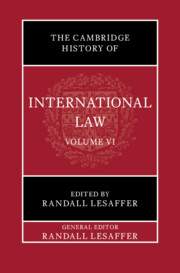Book contents
- The Cambridge History of International Law
- The Cambridge History of International Law
- Frontispiece
- The Cambridge History of International Law
- Copyright page
- Contents
- Plates
- Contributors
- Preface
- Abbreviations
- Part I International Law in Renaissance Europe (1492–1660)
- 1 The Law of Nations in Renaissance Europe
- 2 Territory and Jurisdiction in Renaissance Europe
- 3 Beyond the Free Sea
- 4 War and the Use of Force in Renaissance Europe
- 5 Warfare on Land in Renaissance Europe
- 6 The Law of Maritime Warfare during the Transition between Medieval and Early Modern Europe
- 7 Peacemaking in Renaissance Europe
- 8 Trade and Navigation in Renaissance Europe
- 9 Diplomacy in Renaissance Europe
- 10 Dispute Settlement in Renaissance Europe
- 11 The Ottoman Encounter and the Law of Nations in the Renaissance
- Part II International Law in Old Regime Europe (1660–1775)
- Index
- Plate Section (PDF Only)
- References
1 - The Law of Nations in Renaissance Europe
from Part I - International Law in Renaissance Europe (1492–1660)
Published online by Cambridge University Press: 22 April 2025
- The Cambridge History of International Law
- The Cambridge History of International Law
- Frontispiece
- The Cambridge History of International Law
- Copyright page
- Contents
- Plates
- Contributors
- Preface
- Abbreviations
- Part I International Law in Renaissance Europe (1492–1660)
- 1 The Law of Nations in Renaissance Europe
- 2 Territory and Jurisdiction in Renaissance Europe
- 3 Beyond the Free Sea
- 4 War and the Use of Force in Renaissance Europe
- 5 Warfare on Land in Renaissance Europe
- 6 The Law of Maritime Warfare during the Transition between Medieval and Early Modern Europe
- 7 Peacemaking in Renaissance Europe
- 8 Trade and Navigation in Renaissance Europe
- 9 Diplomacy in Renaissance Europe
- 10 Dispute Settlement in Renaissance Europe
- 11 The Ottoman Encounter and the Law of Nations in the Renaissance
- Part II International Law in Old Regime Europe (1660–1775)
- Index
- Plate Section (PDF Only)
- References
Summary
The sixteenth and early seventeenth centuries marked a deep crisis of the international political and legal order of Europe, caused by the Reformation, the emergence of some strong composite monarchies and the discovery of the New World. The chapter maps how the law of nations began to emerge as a new paradigm for the governance of Europe under whose wings rulers, diplomats and scholars attempted to advance claims to an exclusive jurisdiction over international relations by sovereign princes and republics. As such, the ‘law of nations’ functioned as a lever, an argument for power in a period of great clashes between centralising governments, opposing confessions, and regional and local elites, rather than representing a reality. The ultimate success by governments in several important states at the end of the Renaissance was facilitated to a great extent by the patrimonial and transactional nature of the states that allowed to include old, autonomous powers in the machinery of state.
- Type
- Chapter
- Information
- The Cambridge History of International Law , pp. 3 - 57Publisher: Cambridge University PressPrint publication year: 2025

